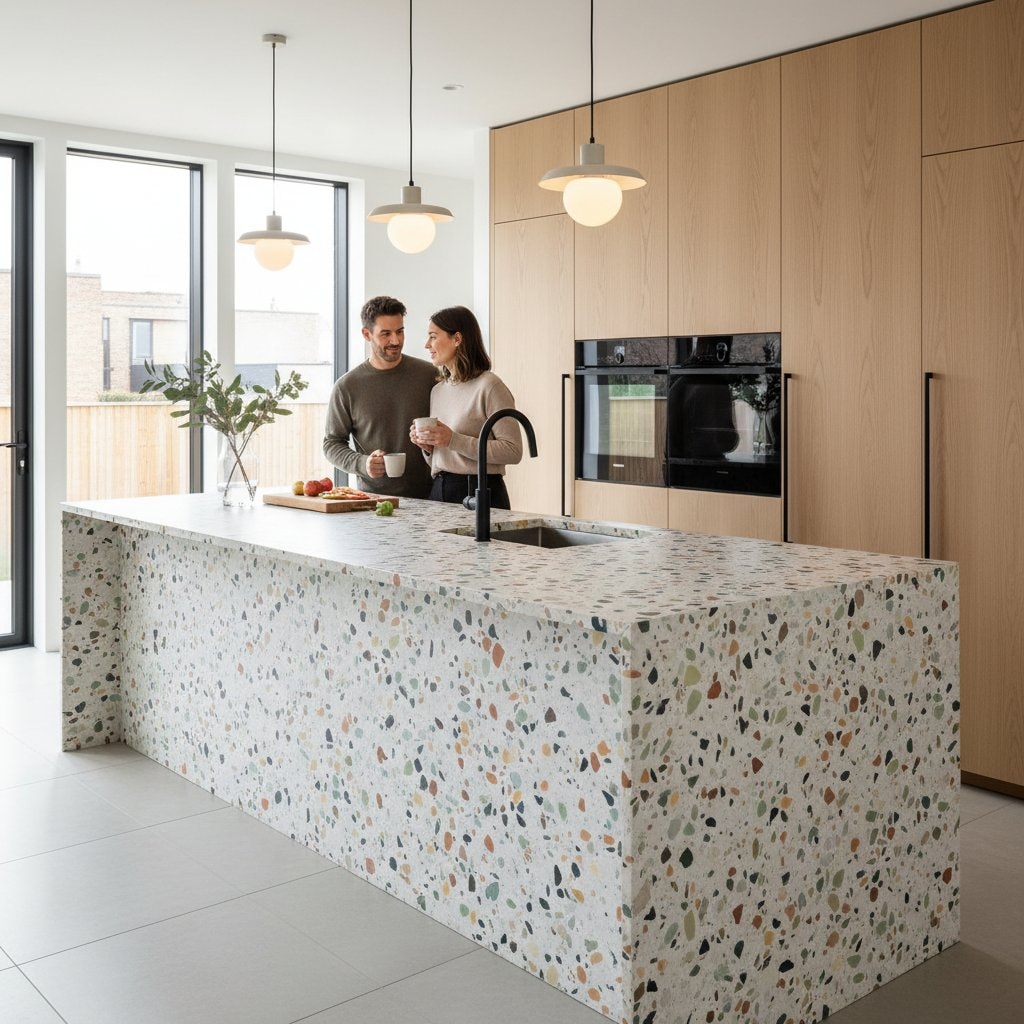Terrazzo’s Sustainable Revival: Floors, Counters, and Beyond
Imagine entering a contemporary café or a sleek residential kitchen and encountering a speckled surface that evokes nostalgia while projecting modernity. This surface is terrazzo, experiencing a robust revival. Originally prominent in mid-century educational institutions and transportation hubs, terrazzo now graces residential spaces for its resilience, reduced waste generation, and extensive customization possibilities. For individuals planning renovations, terrazzo offers an optimal fusion of aesthetics, functionality, and environmental responsibility.
This article examines the reasons behind terrazzo's renewed popularity in kitchens, bathrooms, and entryways. It also provides guidance on integrating this material thoughtfully into personal environments.
Reasons for Terrazzo's Enduring Appeal
Terrazzo possesses an inherent timelessness. Artisans create it by embedding chips of marble, glass, quartz, or repurposed elements into a cement or epoxy matrix, followed by polishing to achieve a seamless finish. This technique yields a unique pattern of colorful flecks and subtle depth, distinct from uniform concrete or standard tiles.
Recent shifts in homeowner priorities toward sustainability and enduring investment have elevated terrazzo's status. The material incorporates surplus stone and glass that would otherwise contribute to waste streams, while requiring little upkeep over many years. In contrast to synthetic alternatives or transported natural stones, responsibly sourced and installed terrazzo minimizes ecological impact.
Customization options abound with terrazzo. Select subdued palettes for understated elegance or vibrant combinations for contemporary flair. The versatility accommodates diverse styles, ranging from clean-lined Nordic designs to playful vintage-inspired kitchens.
Key Characteristics of the Material
Prior to selection, familiarize yourself with the primary variants: cement-based and epoxy-based terrazzo.
- Cement-based terrazzo represents the classic approach. It delivers a natural, matte appearance suitable for exterior applications. Although curing demands more time and installation incurs marginally higher expenses, this option excels in longevity and permeability.
- Epoxy-based terrazzo employs a resin binder. It facilitates slimmer applications, quicker setup, and more vivid hues. This variant thrives indoors but requires avoidance in areas prone to subfreezing temperatures.
Both categories accommodate recycled components like fragmented glass, porcelain fragments, or metallic inclusions. To prioritize ecological benefits, seek vendors providing substantial recycled proportions and regionally obtained materials.
Pricing and Installation Essentials
Terrazzo demands an initial investment, yet its extended service life justifies the expenditure. Professional installation for flooring generally ranges from $25 to $80 per square foot, influenced by binder choice, aggregate variety, and pattern intricacy. Epoxy formulations often fall toward the spectrum's lower boundary.
Countertop installations, encompassing fabrication and sealing, typically cost $75 to $120 per square foot. This pricing aligns with high-end quartz or genuine stone, surpassing basic laminates or engineered surfaces.
Floor preparation constitutes a precise endeavor. It requires a level subfloor, mixture pouring, grinding, polishing, and sealing, spanning multiple days with dedicated tools. Professionals handle full-scale projects effectively; amateurs may manage minor accents but should avoid comprehensive flooring or expansive counters.
Optimal Placement for Terrazzo
Terrazzo's seamless, non-porous nature ensures performance in demanding, moisture-exposed zones.
Recommended Uses
- Kitchen flooring and surfaces – Properly sealed, it resists stains, scratches, and daily use.
- Bathroom fixtures and enclosures – Provides a streamlined aesthetic with straightforward sanitation.
- Entry zones and utility areas – Endures intensive foot traffic and debris accumulation.
- Exterior terraces (cement-based only) – Withstands elemental exposure without degradation.
Additional venues include splash guards, staircase risers, furniture tops, or hearth surrounds. Coordinating multiple features within a room fosters unified, sophisticated interiors.
Upkeep and Preservation
Terrazzo's prominence in institutional settings stems from its undemanding care routine. Routine cleaning involves neutral soap, water, and a gentle cloth or mop. Steer clear of corrosive agents or acidic solutions, as they compromise the polish.
Periodic resealing, every several years, safeguards against discoloration and preserves luster. Epoxy variants necessitate this step less often. Minor damages, such as chips or fissures, yield to expert repairs without necessitating wholesale renewal. Consistent maintenance extends terrazzo's lifespan beyond comparable coverings.
Ecological Advantages and Sustainable Practices
Terrazzo merits its green credentials through composition. Producers frequently incorporate up to 70 percent recycled elements, such as reclaimed glass, stone offcuts, and manufacturing byproducts. This practice curtails landfill contributions and virgin resource extraction.
The material's durability obviates repeated substitutions, aligning with green construction protocols. During eco-certified remodels, terrazzo supports objectives for waste reduction and emission control.
Logistics influence overall sustainability. Opt for locally procured aggregates and binders to lessen transport-related emissions. Consult installers regarding procurement practices prior to final decisions.
Customization Possibilities and Design Choices
Terrazzo's allure intensifies during the planning phase. Tailor aspects including:
- Chip dimensions: Fine granules produce elegance, whereas coarser sizes form striking motifs.
- Hue selections: Blend base tones with contrasting glass or stone accents.
- Surface treatments: Opt for glossy polish, soft honing, or textured brushing for traction.
- Layout configurations: Employ uniform expanses or intricate divider-embedded motifs.
Professionals leverage terrazzo to harmonize disparate elements. For instance, a countertop mirroring adjacent flooring hues establishes equilibrium and seamless transitions.
Cost-Effective Incorporation Tips
For budgets constraining full-scale implementations, explore scaled applications that capture terrazzo's essence.
- Select prefabricated terrazzo tiles for simplified setup and reduced pricing.
- Consider quartz or laminate variants emulating terrazzo aesthetics.
- Integrate accessory items like vessels, surfaces, or storage units for focal points.
Pairing terrazzo with complementary eco-materials, such as bamboo or resilient flooring, balances expenses while upholding sustainability.
Steps to Integrate Terrazzo Successfully
To pursue terrazzo integration, gather material swatches and inspirational visuals reflecting preferred motifs. Share these with a regional specialist versed in both visual and structural demands.
Anticipate a lead period of weeks for bespoke mixtures or assembly. The anticipation proves worthwhile, as installed terrazzo delivers unparalleled resilience and character to living spaces.
Terrazzo's resurgence transcends fleeting fashion. It embodies a commitment to resilient, environmentally considerate design choices that enhance daily environments for generations.










